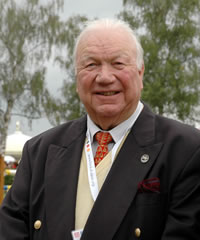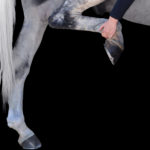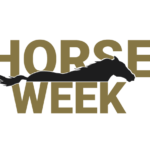[/caption]

Aachen, Germany, August 24, 2006 — I was trying to think of a bright and cheery way to start off this World Equestrian Games (WEG) article, but the biggest news of the day is not good, and I’m afraid there’s no way around it.
You’ve heard about Brentina being withdrawn from tomorrow’s Grand Prix Special because of a swelling in her right hind leg. That was so disappointing. Her rider and best friend, Debbie McDonald, felt something wasn’t quite right at the end of her Grand Prix test yesterday that clinched the bronze medal–and a spot in the 2008 Olympics–for the U.S. Unfortunately, Debbie was right.
While I’m sad not to be seeing Brentina compete again here, the team medal was always her mission, and it’s now mission accomplished. So let’s hope with a rest that she’ll improve enough to come out again at the 2007 World Cup finals in Las Vegas, which Debbie would like to do. Brentina loves to show, so that probably would be her ambition too.
If she can’t compete in the World Cup, maybe she could be retired during the Vegas show, in the arena there named for her owner and Debbie’s sponsor, Parry Thomas.
Debbie also mentioned the possibility of motherhood for Brentina, but I want you all to know that whatever happens, that mare has a wonderful home for life, and I’m sure she’ll be as pampered in retirement as she was during her career.
Although I’m down about the Brentina situation, she is doing fine, and that’s some consolation.
But what’s really sad is the fate of the poor endurance horse who had to be put down today. Dubai, an 11-year-old gelding ridden on the Danish team by Ingelise Kristoffersen, tied up shortly after the start of the race. Officials said the condition “could not have been predicted and was not related to the competition effort.”
Although intensive therapy was undertaken for three days, the horse began to lose kidney function and so there was no alternative but to give him a peaceful end.
Two endurance horses died in the 2002 WEG in Spain; I was hoping we were going to have a clean slate this time around.
Meanwhile, officials decided there was no merit to a protest by the silver medal Dutch dressage team alleging the last rider on the gold medal German dressage team had an advantage because a TV camera was in a different position for her than it was for their last rider. Come on… Whatever happened to the spirit of sportsmanship? I thought this whole thing was really depressing, showing a mindset that does no good for the sport.
Speaking of sport, let’s get back to that.

Today, the dressage phase of eventing started in a small stadium adjacent to the one used by the Grand Prix dressage horses (and next week, the show jumpers). It’s not exactly cozy, but I thought it had an out-in-the-country feeling, even though the bustle of the shopping area was behind it, but there are big fields off to the side and the cross-country course starts out from there.
The best American performance today belonged to Heidi White and Northern Spy. With another day of dressage to go, they stand 10th on 50.4 penalties, but I had the feeling that eager-beaver bay gelding was looking forward to cross-country. I know Heidi is.
“It’s a proper 4-star course. It’s technical, and going to take a lot of riding. We have got six seriously good cross-country horses; it was built for us. I’m glad I’m sitting on the one I’m on for sure,” Heidi said.
Amy Tryon rode Poggio II in a downpour (there were several today; “Aachen weather” it’s called) to kick things off for our side, and she did well to finish right behind Heidi in 11th place with 50.7 penalties.
Our other rider today was Jan Byyny, who is competing as an individual (i.e. not on the team) with Task Force. Like a number of the horses, he was overeager and fresh in the cooler weather, bolting when he entered the stadium. But Jan wasn’t in the dressage ring yet and got him back in hand before her test. After he was scored at 53.3 to stand 15th, Jan promised him he wouldn’t have to do any more dressage for awhile.
But British rider Daisy Dick had bigger trouble, because her mount, Spring Along, didn’t want to trot when she turned left at C after her halt. He insisted on cantering, and so he did for about half the ring, until his rider finally convinced him to follow her directions. She is 29th on 64.3 penalties, which is a downer for that team.

German rider Frank Ostholt had to cope with a buck as he cantered across the middle of the arena on Air Jordan, but he handled it without blinking and was able to escape with only 46.9 penalties to place fourth. Germany leads the standings (no surprise) with Andreas Dibowski on FRH Serve Well. He was marked at 40.9 penalties. The Germans, favored by many to take the team gold in this discipline, are off to a roaring start except for one thing–Andreas is riding as an individual and is not on the team.
I think if you want to do well in this WEG, it might be helpful to be named Andreas. Remember the top scorer in the dressage Grand Prix was Andreas Helgstrand.
Australia is in the lead at this point, with Germany second (they would be first if Andreas were on the squad, bet the selectors are squirming now!) and the U.S. is third. But things could easily change by tomorrow night.
I spent part of the afternoon at vaulting and it was fun! The cheers and stomping of the crowd, the way the vaulters march into and out of the ring like prancing ponies, their dexterity and suppleness–all were a delight. These athletes are beautiful specimens; one extra ounce on their bodies, and it would show in the form-fitting costumes they wear.
But Mary McCormick, a team member and coach herself, said it’s not dieting that keeps these young people slender, it’s the constant workouts necessary to be fit enough to do this challenging sport of gymnastics on horseback. When they’re not jumping on and off a cantering horse, they run, swim, lift weights and do core-strength routines such as Pilates.

Mary was hanging out with Megan Benjamin, who is leading the standings in the individual female medal race after the compulsory exercises. These include such moves as sitting on the horse backwards, riding with arms out to the side and kneeling on the horse with one arm thrust forward and one leg raised back. I couldn’t even do that on my floor (which doesn’t canter).
Compulsories are not as spectacular to watch as the freestyle, where you see all those lifts and jumping in the air and other dramatic techniques, but it was still pretty darn impressive.
Megan, like all but one member of the U.S. vaulting contingent, is from California. She owns a Danish warmblood named Leonardo who lives in Denmark and uses him when she competes in Europe.
“My horse really helped me,” she said. “He did his job.” Truthfully, I didn’t know until today how big a role the horses can play in the vaulting results.
The U.S. team stands fifth, with Germany (as usual, it seems) leading the way. The Americans were hampered when their horse, too, was fresh and cantered a bit too fast, which made some of the more technical moves harder to do.
Hope all the news is better tomorrow. Don’t forget to check for my article then.
Visit EquiSearch’s WEG section for more stories, blogs and online diaries. Chat about the WEG with fellow fans on the EquiSearch Forum.






